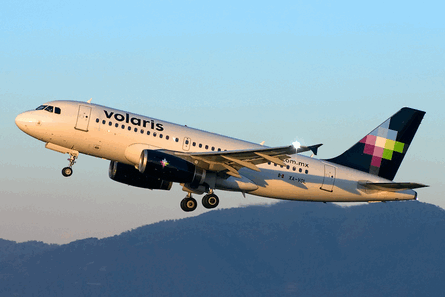VivaAerobus and Volaris are preparing to launch services at Mexico City International Airport, signalling a possible strategy shift made possible by a dramatic change in government policy.Mexico’s government in December opened up the downtown airport to VivaAerobus and Volaris, reversing a policy blocking new entrants.
The only exception until now was Interjet, which was able to circumvent the policy in 2008 by acquiring Mexico City slots from grounded AeroCalifornia in a controversial transaction that was challenged by the country’s legacy carriers.
The decision to open up Mexico City International comes as there are now plenty of unused slots given capacity cuts and the demise of Aviacsa, which had Mexico City’s third largest operation. Interjet chief executive Jose Luis Garza says Aviacsa’s slots have not yet been reallocated but there are already plenty of available slots except during two peak hours. Garza applauds the new policy, saying “we’ve always believed in competition”, and says it should also benefit Interjet.
 |
|---|
Toluca-based Volaris has always indicated it had no interest in serving Mexico City and in 2008 even criticised Interjet's new strategy, claiming it made no sense to split operations between the capital's two airports. “You can’t have low cost in Mexico City,” chief executive Enrique Beltranena told Airline Business at the time. “In terms of strategy we’re building up Toluca. Our model is working. I don’t see why we should change gears.
Volaris marketing director Jose Calderoni says its launch at Mexico City is not really a strategy reversal as it will only serve it from Tijuana: “The focus is still on Toluca. This is just another station for us.” Calderoni points out that Tijuana is now Volaris’ largest base with 13 destinations. “This is about our Tijuana strategy,” he explains. “This strengthens our position in Tijuana. Our Tijuana customers are asking for this. We’re very dominant in Tijuana.”
|
|---|
VivaAerobus provided a similar rationale in explaining its decision to launch service to Mexico City from its Monterrey and Guadalajara bases. VivaAerobus, which currently does not serve Mexico City or Toluca, has traditionally has stuck to niche routes and avoided competing with other carriers.
Guadalajara-Mexico City and Monterrey-Mexico City are by far the country’s two largest and most competitive routes but VivaAerobus say they represent “natural growth” for the airline given its large presences in Guadalajara and Monterrey. The carrier says its Guadalajara and Monterrey passengers have frequently requested the airline to serve Mexico City and VivaAerobus has no plans to open a base in Mexico City or serve the capital from other cities.
The Mexico City routes come as part of a dramatic expansion at VivaAerobus which will include a total of 11 new domestic routes during the first four months of this year. The carrier, which had not added any aircraft in a year and a half, is expanding its fleet from seven to 11 Boeing 737-300s to support the larger network.
|
|---|
Interjet and Volaris also plan to resume fleet expansion this year with Interjet aiming to grow from 15 to 17 Airbus A320s and Volaris from 21 to 23 A319/A320s. Mexico’s three surviving low-cost carriers believe now is the time to again pursue expansion because Mexico’s market has stabilised after a rough couple of years which has resulted in the demise of several competitors. But Garza warns the market has still not fully recovered and while the domestic market is expected to grow in 2010 after a double-digit drop last year the growth will likely be in the low single digits.
Source: Airline Business
















